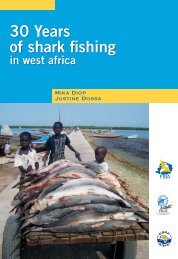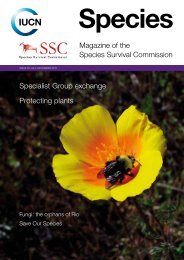Kyne & Simpfendorfer.. - Shark Specialist Group
Kyne & Simpfendorfer.. - Shark Specialist Group
Kyne & Simpfendorfer.. - Shark Specialist Group
Create successful ePaper yourself
Turn your PDF publications into a flip-book with our unique Google optimized e-Paper software.
16 embryos (Table 2.5). Irvine (2004) found strong correlations between maternal size and<br />
the number of follicles and the number of embryos and within the New Zealand lanternshark<br />
E. baxteri from southern Australia and Yano (1995) found similar results for the black<br />
dogfish C. fabricii from Greenland.<br />
Etmopterids do not appear to have well-defined reproductive seasons, and have a noncontinuous<br />
reproductive cycle with an apparent resting stage after parturition. This is<br />
supported by observations that follicles do not continue to develop throughout gestation (i.e.<br />
gravid females do not possess developing or mature oocytes) and the finding of numerous<br />
large females with inactive reproductive tracts (Yano 1995, Daley et al. 2002, Irvine 2004).<br />
With species exhibiting aseasonal reproductive cycles, the duration of any resting stage after<br />
parturition and prior to next ovulation is difficult to assess as each reproductive stage occur<br />
can be found in any month sampled (Irvine 2004). Furthermore, gestation period has not been<br />
calculated.<br />
Age estimates are available for only two species of lanternshark, and these are unvalidated<br />
and thus should be considered as preliminary (Gennari et al. 2002, Sion et al. 2002, Irvine et<br />
al. 2006a). Irvine et al. (2006a) estimated age from both internal and external bands on the<br />
second dorsal spine of E. baxteri. While there were considerable differences in age<br />
estimations between these techniques (see Table 2.6), Irvine et al. (2006b), in an aging study<br />
of the somniosid Centroselachus crepidater, suggested that internal bands may underestimate<br />
age. Similarly, for E. baxteri, internal bands become unreadable as internal dentine appears to<br />
stop forming in adult fish (Irvine et al. 2006a). As such, count estimates from external bands<br />
are more reliable, and for E. baxteri this technique gives a maximum age of 57 years for<br />
females and 48 years for males, with age at 50% maturity of 30 years for females and 20<br />
years for males (Irvine et al. 2006a). Vertebral band counts for the velvet belly E. spinax from<br />
the Mediterranean present 7 bands for the largest individuals (Gennari et al. 2002, Sion et al.<br />
2002). There is a considerable size difference between E. spinax which rarely reaches<br />
>450mm TL (although can reach 600mm TL) and E. baxteri with reaches 880mm TL<br />
(Compagno et al. 2005).<br />
Irvine (2004) calculated lifetime fecundity for E. baxteri, utilising a mean litter size of 6-12<br />
(variable with maternal size) and the number of reproductive years as 27, and applying either<br />
a two or three year reproductive cycle. If the species reproduces biennially, Irvine (2004)<br />
calculated that the lifetime fecundity of a female E. baxteri is 128 pups, and if it reproduces<br />
triennially, then the lifetime fecundity would be 81 pups.<br />
74
















